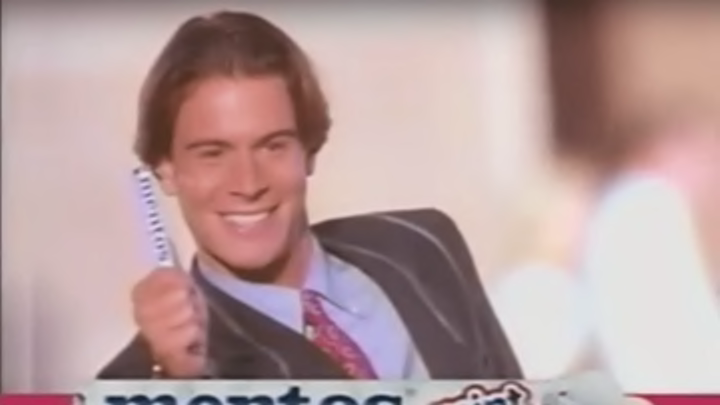Candy Crush: The Bizarre History of Those '90s Mentos Commercials
By Jake Rossen

In the fall of 1996, Liam Killeen walked into a convenience store in Erlanger, Kentucky, near the U.S. offices of Van Melle (now known as Perfetti Van Melle), the candymaker behind Mentos. While paying for his purchase, Killeen—Mentos's vice president of marketing—noticed that the cashier was eyeing him with a mixture of suspicion and disgust.
Killeen asked if there was a problem. She pointed to the Mentos logo on the company jacket he was wearing. “Mentos?” she spat. “I hate those commercials. They’re so cornball! So stupid!”
It was not the first time Killeen had heard such a strong, visceral reaction to the ad campaign he helped devise. Beginning in 1992, the Netherlands-based confectioners had stormed the States with a series of inexplicably odd television spots that featured an earwig of a song (“Fresh Goes Better”), hammy acting, and a general sense that the ads were trying to approximate American culture rather than actually be a part of it—not unlike a robot mimicking the emotions of its human counterparts.
Some people loved the ads; a lot of people didn’t. (In 1994, USA Today voted it one of the worst advertising campaigns.) But the ads did what they were supposed to do. In 1991, Van Melle sold $20 million worth of the hard candies. In 1994, that number doubled to $40 million. By 1996, it had tripled to $120 million. By either design or accident, Mentos became a leader in the sweets industry by producing commercials that were almost incomprehensibly stupid.
It was during a train ride to Poland in 1932 that brothers Michael and Pierre van Melle originally had the inspiration to develop and market a peppermint-flavored caramel candy. Calling the bite-sized pieces Mentos, Van Melle began exporting them in the 1950s; in 1972, Mentos arrived stateside.
With minimal marketing and little name recognition, Mentos were largely lost in candy aisles, selling modestly for nearly 20 years. Around the time Killeen joined the U.S. sales office in 1991, the decision was made to begin a more aggressive grab for market share. First, Mentos would reduce the number of available flavors from 50 to just two: mint and mixed fruit. Second, they would pursue a global ad campaign marketed directly to consumers instead of the trade ads Van Melle had typically produced for candy distributors and suppliers.
Ad agency Pahnke & Partners out of Hamburg, Germany was enlisted to conceptualize the spots, which had several recurring themes: A young, attractive couple would find themselves in some sort of bind that would usually be remedied by popping a Mentos and subsequently having a spark of inspiration. One of the leads would hold up the Mentos package and give a thumbs up. Throughout, a song would play that was intended to sound catchy no matter where in the world the commercials were airing.
In one spot, a man decides to don a tablecloth and pretend to be a waiter in order to garner better service. In another, traffic impedes two lovers from embracing. At the climax of the 30-second spots, a brand slogan—“The Freshmaker”—would appear onscreen.
Viewers who spotted the ads when they premiered in July 1992 were driven to distraction by one intangible: The ads seemed disconnected from actual human behavior, and the song itself was critiqued for appearing to be an English translation that didn’t get the lyrics quite right. (“It doesn’t matter what comes, fresh goes better in life.”)
By the mid-1990s, both news media and the burgeoning world of the internet had become preoccupied with the unreality of Mentos. Much of the speculation revolved around whether the commercials were shot in the U.S. or elsewhere. (According to the company, three of the commercials were shot in the States, while seven were produced overseas.) An early "Mentos FAQ" was set up by Purdue University student Heath Doerr, who pored over minutiae in a way that would foreshadow the obsessive online fan cultures that followed.
Van Melle recognized a phenomenon when they saw it and rarely responded to media requests for information about the campaign. "It's almost more fun to have consumers off on their own," Mentos brand manager Tricia Gold told The New York Times in 1995. "If we added our input, it would stop the free flow of information."
People could mock and inspect the ads all they wanted. For Van Melle, the curiosity led to brand awareness that couldn’t have been obtained purely through ad buys. By 1996, Mentos had reached $135 million in sales and was being mentioned or parodied in a number of high-profile spots. The Foo Fighters released a video, “Big Me,” which mocked the cheesiness of the ads; the candy was name-dropped in 1995’s Clueless; the brand got sustained exposure during an entire season of Baywatch.
The novelty began to wear off around 1999, when Mentos's sales had leveled despite major growth in what Ad Age dubbed the “strong mint category” of treats. Altoids was eating into market share, and Mentos-sponsored college concerts weren’t making much of a dent. After roughly a decade of near-constant rotation, the Freshmaker campaign began to settle down in 2002. Despite their reduced role in popular culture, Mentos remain a top-ranked mint in the confection business.
Jesse Peretz, who directed the Foo Fighters's parody video, may have summed up Mentos mania best. “The commercials,” he told Entertainment Weekly, “are total lobotomized happiness.”